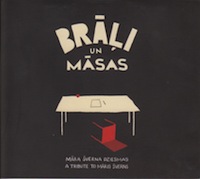Though perhaps not reaching similar commercial heights as other popular Latvian artists, the band Baložu pilni pagalmi, in their long and prolific career (having just released their 10th studio album – Stacija mums in 2014) the group became one of the most significant and influential bands in the Latvian alternative rock scene.
The creative force behind Baložu pilni pagalmi for twenty years has been vocalist and guitarist Māris Šverns. Šverns and Baložu pilni pagalmi over the years gathered a devoted, if comparatively small, following, and inspired many future Latvian underground musicians to try their craft in songwriting.
Recognizing the singular influence of Māris Šverns and his status as godfather of Latvian indie music, a number of both well-known and lesser known artists pay tribute to the songwriter on the 2014 album Brāļi un māsas. Sixteen groups provide their unique interpretations of Šverns’ songs, reflecting the varied and diverse nature of Šverns’ works.
Elizabete Balčus, who was awarded the ‘Best Debut’ Latvian music award in 2011, begins the albums with an dreamy, string drenched interpretation of the song ‘Smarža’, along with a soaring vocal performance.
The groups collected on the album are often difficult to pigeonhole in one single genre, much like Šverns himself. For example, Oranžās brīvdienas, who combine heavy guitars and a horn section, perform a jumpy version of ‘Tava māja’, with staccato horns alternating with bass guitar. Though Šverns’ lyrics might at first seem simplistic, they belie deeply personal emotions and feelings.
Quirky Baložu pilni pagalmi contemporaries Inokentijs Mārpls, performing what could be called ‘Latvian hardcore’, perform a blistering version of ‘Nebija vēja’, combining distorted guitars and growling vocals in their inimitable style.
Sniedze Prauliņa, daughter of Latvian composer Uģis Prauliņš, performs a Tori Amos imbued rendition of “Labākā šaipus piena ceļa”. Joining Prauliņa is Edgars Šubrovskis, the vocalist of Latvian indie stalwarts, the unfortunately disbanded Hospitāļu iela. Šubrovskis, who initiated this project and also selected the artists that appear on the record, returns with his new band Manta to perform an Eastern flavored version of ‘Kūkojam’.
In a collection that contains many unusual recordings, one of the most unexpected performances is by the choir Juventus, who recorded an a capella choir version of Šverns’ song ‘Mans zirgs’. The soaring harmonies by the female voices beautifully balance the melody song by the tenors, and may remind the listener of a similarly successful choir song arrangement – that of Renārs Kaupers’ ‘Mazā bilžu rāmītī’. The plaintive song about a horse, with its deceptively childlike words and music, turns out to be a fitting song for a choir interpretation, as the voices alone reveal the tender beauty of the song.
The Brāļi un māsas collection features not only artists from Latvia, but also diaspora Latvian artists, proving the global influence of Šverns’ songs. Swedish Latvian group Alis P performs their rendition of “Katru rītu”, and veteran American Latvian alternative group Mācītājs on Acid perform an appropriately fuzzy version of “Katru minūti”.
Yet another example of the genre-bending reach of Šverns’ songs is the performance of the song “Iela, pa kuru tu ej” by jazz rock ensemble Pieneņu vīns, with jazz style vocalizations that at once seem out of place, yet, at the same time, seem perfectly appropriate to the song.
Māris Šverns, a guiding light for so many alternative and indie musicians in Latvia, along with Baložu pilni pagalmi, continues to build on his 20 year legacy of personal and individualistic songwriting. Brāļi un māsas is an appropriately eclectic tribute to an eclectic songwriter.
For information about Brāļi un māsas, please visit this website and more about the band Baložu pilni pagalmi can be found here.
Track listing
- Smarža – Elizabete Balčus
- Tava māja – Oranžās Brīvdienas
- Radiohīts – Stūrī Zēvele
- Cilvēks tik uz pus – Satellites LV
- Nebija vēja – Inokentijs Mārpls
- Romāna varonis – Gaujarts
- Labāka šaipus piena ceļa – Sniedze Prauliņa
- Meitene – Anna Ķirse, Māris Butlers, Toms Auniņš
- Mans zirgs – Koris Juventus
- Kūkojam – Manta
- Katru rītu – Alis P
- Pavasaris – Laika suns
- Katru minūti – Mācītājs on Acid
- Iela, pa kuru tu ej – Pieneņu vīns
- Tik vēlu – Frontline
- Mans lepnums – Sonntags Legion





